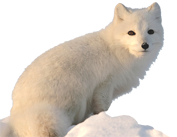Objectives
- To improve information for use by the NWMB and its co-management partners in establishing, modifying, and/or removing total allowable harvests, basic needs levels, non-quota limitations, and for assisting with decisions regarding approval of management plans and approval of the proposed listing of species under the federal Species at Risk Act (SARA);
- To acquire data, and Inuit and local ecological knowledge for use in identifying management zones, areas of high biological productivity, and critical harvesting areas, documenting species abundance and movement patterns, for setting wildlife research and management priorities, and for directing further research efforts;
- To maintaining a progressive, up-to-date management system which takes into account emerging issues, concepts and principles in wildlife management; and
- To maximize the benefits of the community in achieving these objectives.
The community-based monitoring network will focus on identifying and employing the skills and knowledge of the most respected, professional and accomplished hunters in a community; this may include individuals who aren’t currently hunting to their full potential because of financial constraints or limitations. Once identified, these hunters will be compensated for recording local ecological knowledge in the form of catch data and wildlife observations while out on the land (e.g. wildlife sightings, distribution, migration patterns). The data will be downloaded and compiled by a responsible community member. The network will provide participating communities with the tools and skills they need to maintain a long-term self-sustained monitoring network and database.
The NWMB ultimately intends to implement the community-based monitoring network across Nunavut. Currently, however, the NWMB has undertaken to conduct a pilot study to assess the proposed methods of data collection and management. Feedback from participants and other members of pilot communities will be valuable in revising, and re-developing initial procedures and protocols to follow in implementing the monitoring network across Nunavut, allowing for adaptive management of all aspects of the project and ensuring that the concerns of the communities are addressed. The pilot study in anticipated to begin in the summer of 2011, and continue through until the fall of 2012.
Benefits to Nunavut Communities
- Recording locations of harvest and observations could identify critical harvesting areas and important habitats;
- Provides a way of collecting local ecological knowledge concerning species movements, abundance, habitat use, and other ecological or environmental considerations;
- Will improve our understanding of key conservation concerns from the communities, which will provide the communities with a greater role in management of their diverse hunting areas;
- Will provide insight concerning species of importance that are not actively managed at present (e.g. ringed seals);
- May result in identifying areas that require more in-depth research and will incorporate community input in prioritizing these issues;
- Will provide the potential for long-term monitoring that is important for successfully managing wildlife populations;
- Will provide data that could be used to address issues regarding harvesting rights, land-use, and development; and
- Could assist in compensation claims (i.e. would provide proof of loss of harvesting income resulting from proposed shipping routes, mining development activities).


